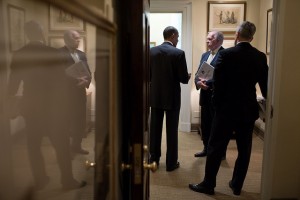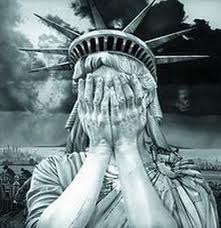The Advance Declination Letter and the White House Meetings
John Sifton has a piece at JustSecurity on a key new detail in the torture report: a description of a letter the CIA lawyers were sending around discussing getting an advance declination (though unless I’m misreading the report, this email chain is dated July 8, not April).
But perhaps the most important revelation in the report is not about the torture itself but rather about the legal culpability of the CIA. The report contains a key passage on page 33 revealing that senior lawyers at the CIA in mid 2002, at the very beginning of the CIA’s program, drafted a letter to the Attorney General in which it is expressly acknowledged that the interrogation tactics that came to be known as “enhanced interrogation techniques” violated the US torture statute. The draft letter requested that the Attorney General provide the CIA with “a formal declination of prosecution, in advance”—basically, a promise not to prosecute, or immunity. The document was shared even with CIA interrogators involved in the nascent program. From the beginning, in other words, key CIA officials were well aware that these techniques were clearly unlawful.
While the date is off slightly, that appears to be the email chain I pointed to in this post, which was described as — and may be — “an issue that arose.” (Remember that CIA had already exceeded the guidelines they’d been given on sleep deprivation.)
That least to the timeline laid out in this post (though the post was wrong about ongoing torture — Abu Zubaydah was being held in isolation at that point).
As I pointed out in an earlier post, when Counterterrorism Center lawyer Jonathan Fredman sent the torturers in Thailand a green light for torture in August 2002, he relied on language about intent from a July 13, 2002 fax from John Yoo to John Rizzo rather than the finalized August 1 Bybee Memo. In a second post on this, I also showed that both of Yoo’s nominal supervisors–Jay Bybee and John Ashcroft–claim they knew nothing about that fax. In this post, I’m going to show how that fax appears to arise out of DOJ discomfort with CIA’s torture program.
As the timeline below shows, Yoo dated (but did not send) the fax the same day that the numerous parties involved in reviewing the Bybee Memo had an apparently contentious meeting at which they discussed the draft memo as well as the CIA’s torture plan (I’m doing a big update on the Torture Timeline, so some of this is not reflected in the timeline yet).
July 10, 2002: John Yoo tells Jennifer Koester that they will present the Bybee memo to NSC at 10:45 on July 12 (and names the Bybee Memo the “bad things opinion”!).
July 11, 2002: John Yoo and Jennifer Koester have briefing session with Michael Chertoff on Bybee Memo.
July 11, 2002: An OLC paralegal cite-checks the draft, and someone schedules a July 12 meeting with Alberto Gonzales and a July 13 meeting with (effectively) NSC.
July 12, 2002: First draft of Bybee Memo distributed outside of OLC.
July 12, 2002: John Yoo meets with Alberto Gonzales (and either David Addington or Tim Flanigan) on Bybee Memo.
July 13, 2002: John Yoo and Jennifer Koester present July 12 draft to John Rizzo, John Bellinger, Michael Chertoff, Daniel Levin, and Alberto Gonzales. Rizzo provides overview of interrogation plan. Chertoff refuses to give CIA advance declination of prosecution. Levin states that FBI would not participate in any interrogation using torture techniques, nor would it participate in discussions on the subject.
July 13, 2002: Rizzo asks Yoo for letter “setting forth the elements of the torture statute.”
July 15, 2002: John Yoo faxes John Rizzo July 13 letter on the torture statute.
July 15, 2002: John Yoo sends Jennifer Koester an email telling her to include a footnote in the opinion stating that they had not been asked about affirmative defenses like necessity, self-defense, or commander-in-chief powers.
July 16, 2002: John Yoo and Jennifer Koester meet with Alberto Gonzales and (probably) David Addington and Tim Flanigan. Yoo shared the July 13 fax with them. At the meeting, it is decided that Yoo will include Commander-in-Chief and other affirmative defenses in Bybee Memo.
July 16, 2002: In response to earlier request from Michael Chertoff (perhaps as early as July 13), John Yoo has Jennifer Koester draft, but not send, a letter to CIA refusing a letter of declination of prosecution.
July 17, 2002: George Tenet meets with Condi Rice, who advised CIA could proceed with torture, subject to a determination of legality by OLC.
[snip]
What seems to have happened is the following. Yoo and Koester were all set for an NSC meeting on July 12, perhaps until they had a July 11 briefing with Chertoff. In any case, something made them reschedule that NSC meeting to arrange an Alberto Gonzales (and presumably, Addington) meeting first. After which they appear to have had an incredibly contentious meeting with Bellinger, Chertoff, Levin and others. Perhaps the fact that John Rizzo presented the latest interrogation plan (which, we suspect, was already in process anyway) made things worse. We do know, for example, that mock burial remained in the plan, even after Soufan had balked when Mitchell tried to use it two months earlier. Whether because of Rizzo’s presentation or Yoo’s draft memo, at the meeting Chertoff definitively refused an advance declination and Levin announced that FBI would have nothing more to do with CIA’s torture program.
And so Rizzo, perhaps noting that the head of DOJ’s Criminal Division and the FBI Chief of Staff were reacting rather unfavorably to CIA’s torture plan, asked Yoo for some kind of cover. In response, Yoo wrote a memo raising the bar for prosecution of inflicting severe mental suffering incredibly high.
What I find particularly interesting is the 2-day delay before Yoo sent the fax, dated July 13, to Rizzo on July 15. That likely coincided with another delay; we know Chertoff asked Yoo to send Rizzo a letter refusing advance declination sometime between July 13 and July 16, but Yoo didn’t act on that request until he had sent Rizzo his July 13 fax already.
Did Yoo get both the request for the letter refusing advance declination and the request for the letter laying out the torture statute at the same contentious meeting?
And then there’s one more unexplainable coincidence. On the same day Yoo sent the July 13 memo (on July 15), Yoo instructed Koester they not only wouldn’t include any affirmative defenses in the memo, but they would claim they weren’t asked for such things. Yet that happened just a day before heading into a meeting with Gonzales and (almost certainly) Addington, at which they did decide to include such things. And incidentally–a fact I hadn’t noted before–Yoo gave Gonzales and (almost certainly) Addington a copy of his July 13 fax at the same meeting where it was decided to add affirmative defenses to the Bybee Memo.
I can’t prove it. But it appears that Yoo wrote the July 13 fax in response to serious reservations from Chertoff and Levin. And in response to that, Addington directed him to add a bunch more defenses (literal and figurative) into the Bybee Memo.
One last point. As I said, one key difference between the July 13 fax and the Bybee Memo is that Yoo rebutted an obvious objection to his reading of how the Torture Statute treated intent with severe mental suffering.
It could be argued that a defendant needs to have specific intent only to commit the predicate acts that give rise to prolonged mental harm. Under that view, so long as the defendant specifically intended to, for example, threaten a victim with imminent death, he would have had sufficient mens rea for a conviction. According to this view, it would be further necessary for a conviction to show only that the victim factually suffered mental harm, rather than that the defendant intended to cause it. We believe that this approach is contrary to the text of the statute.
Any bets on whether Chertoff and/or Levin made precisely this argument at that July 13 meeting?
That language — about whether a defendant specifically intended to threaten a victim with imminent death — was reportedly what Jonathan Fredman used to exonerate the people who killed Gul Rahman.
One thing is critically important about this: this is precisely the period when Alberto Gonzales and David Addington were closely involved with the torture report. All this pre-exoneration for crimes came from the White House.


